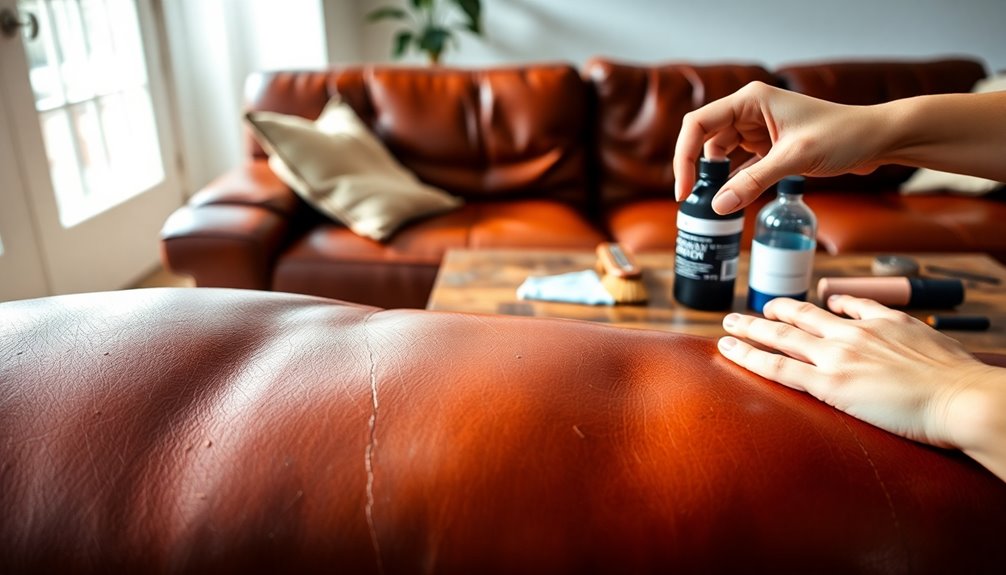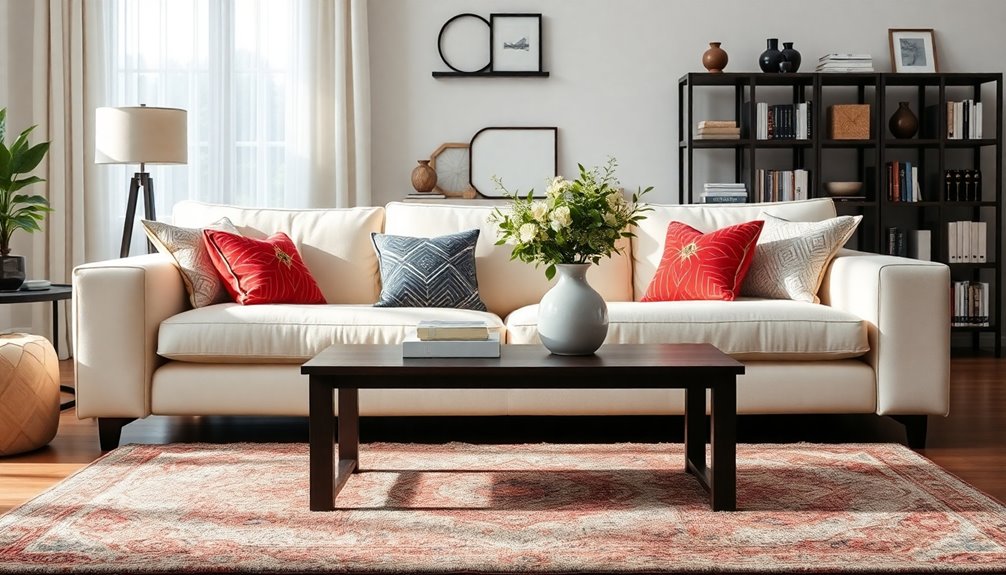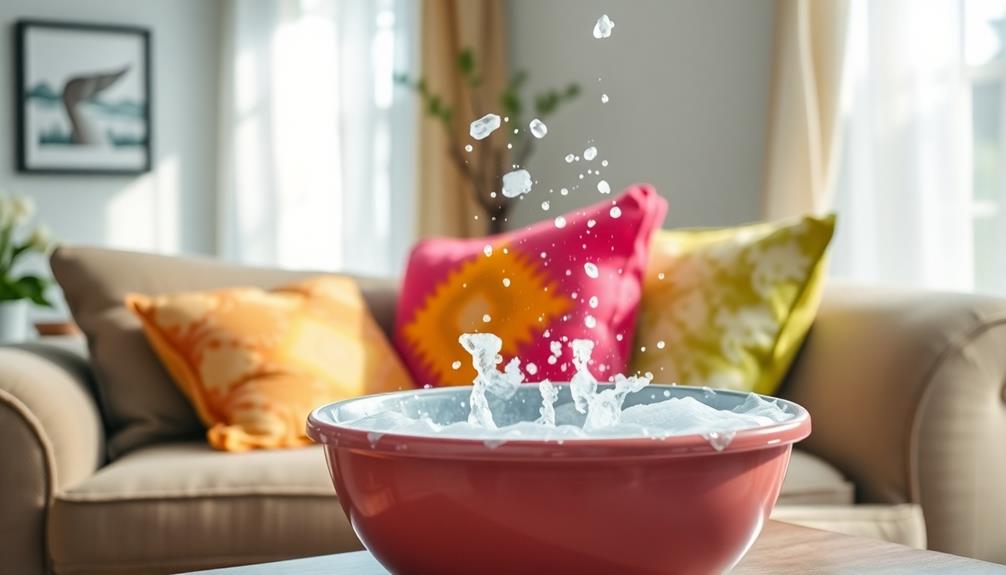Restoring your leather sofa is easier than it seems. Start by cleaning it monthly with a gentle leather cleaner after vacuuming to remove dirt. If you notice any stains, spot clean them immediately with a damp cloth. To keep it in top shape, condition the leather every six months to prevent cracking. Protect your sofa from direct sunlight and apply a leather protectant regularly. If you have faded areas, use leather dye or color restorers for touch-ups. With these steps, your sofa can look fresh and renewed, and there's more to explore to ensure its longevity and beauty.
Key Takeaways
- Clean the leather sofa monthly using a damp microfiber cloth and a gentle cleaning solution to remove dirt and maintain surface integrity.
- Use leather dye or color restorers to rejuvenate faded areas, testing products on inconspicuous spots first.
- Condition the leather with a high-quality leather conditioner every six months to prevent cracking and maintain moisture.
- Regularly apply leather protector spray to guard against stains and moisture, enhancing the sofa's longevity.
- Inspect seams for wear and repair with high-quality bonded nylon thread, using fabric glue for added strength.
Introduction
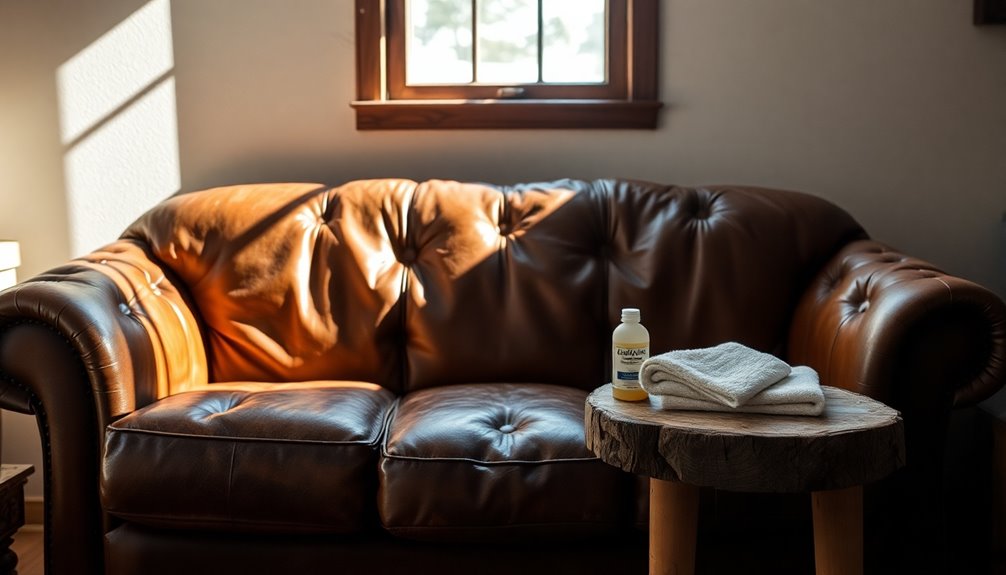
Restoring your leather sofa starts with understanding essential care tips to keep it looking great. You'll want to learn the right cleaning techniques for leather, especially when it comes to tackling pesky grease and food stains. With a little knowledge and effort, you can maintain your sofa's beauty and longevity.
Routine Leather Care Tips
To keep your leather sofa looking its best, regular maintenance is essential. Start by committing to monthly leather cleaning sessions. Use a handheld vacuum with a brush attachment to remove dirt, dust, and oils that can cause long-term damage. After vacuuming, apply a suitable leather cleaner to ensure the surface remains pristine.
Spot clean any spills immediately with a damp cloth to avoid staining. It's crucial to steer clear of harsh chemicals, as they can strip your leather's natural oils and result in deterioration.
Every six months, condition your leather sofa with a high-quality leather conditioner. This step is vital for maintaining hydration and preventing cracking. A well-conditioned sofa not only looks better but also lasts longer.
Additionally, make sure to store your leather sofa in a cool, dry place, away from direct sunlight. This helps prevent fading and drying out over time. By following these routine care tips, you'll keep your leather sofa in great shape, ensuring it remains a beautiful centerpiece in your living space for years to come.
Fabric-Specific Cleaning Techniques
When it comes to cleaning your leather sofa, understanding the type of leather you have is crucial. Different types, like aniline and pull-up, require specific cleaning techniques due to their varying absorbency and protective finishes. For absorbent leathers, avoid harsh chemicals; instead, use a gentle cleaning solution made from equal parts water and white vinegar. This helps you clean and condition the leather without damaging its natural texture.
Always test any leather cleaners on a hidden area first to ensure you won't cause any discoloration or damage. Once confirmed, employ a microfiber cloth to gently lift dirt and grime. Work in small, circular motions, which will help you avoid scratching the leather's surface.
Regular maintenance is key. Cleaning with appropriate products every month can significantly prolong the life and appearance of your leather furniture. By following these fabric-specific cleaning techniques, you'll ensure your leather sofa remains in great shape for years to come. Remember, a little care goes a long way, so make it a habit to clean and condition your sofa regularly!
Eliminating Grease and Food Stains
Keeping your leather sofa clean goes beyond regular maintenance; it also involves tackling grease and food stains promptly. If you notice a grease stain, sprinkle baking soda on the affected area and let it sit for 15-20 minutes. This allows the baking soda to absorb the grease. Afterward, gently brush off the powder with a soft cloth. For food stains, act fast—blot the area with a clean, damp cloth to soak up excess moisture and prevent the stain from setting in.
Next, mix equal parts of white vinegar and water. Use this solution to gently wipe the stained area, which helps lift stubborn residues without damaging your leather. Remember to test any cleaning solution on an inconspicuous area first to avoid discoloration or damage.
After you've effectively cleaned the stain, don't forget the crucial step of cleaning and conditioning. Apply a leather conditioner to restore moisture and prevent your leather from drying or cracking in the affected area. This not only keeps your sofa looking great but also extends its lifespan.
Avoiding Direct Sunlight Exposure
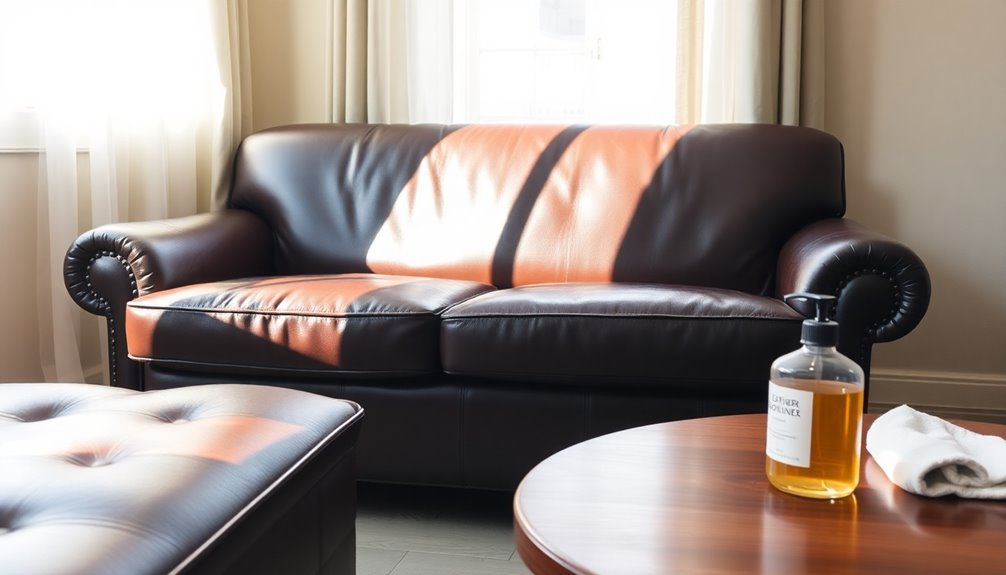
To keep your leather sofa looking its best, you'll want to protect it from direct sunlight. Consider using scratch-resistant fabrics or decorative drapes to shield your sofa from harmful rays. Regularly applying leather protectant can also help maintain its color and integrity, ensuring it stays beautiful for years to come.
Using Scratch-Resistant Fabrics
Protecting your leather sofa from scratches and sunlight damage is essential for its longevity. Using scratch-resistant fabrics as covers or upholstery can significantly reduce everyday wear and tear, prolonging the life of the underlying leather. When selecting these fabrics, opt for materials like microfibers or tightly woven synthetic blends that resist abrasions.
In addition to choosing the right fabric, avoiding direct sunlight exposure is crucial. UV rays can cause leather to fade and dry out. Consider using window treatments or positioning your sofa away from light sources to mitigate this damage. By combining these strategies, you're not just enhancing the appearance of your sofa but also facilitating effective leather repair and leather restoration.
Moreover, applying a protective spray designed for leather can create a barrier against scratches and moisture, boosting the material's resilience to sunlight. Regularly inspecting and maintaining both the leather and any scratch-resistant fabrics ensures your sofa remains in optimal condition, preventing irreversible damage over time. With these precautions, you'll keep your leather sofa looking fabulous and extend its lifespan significantly.
Utilizing Decorative Fabric Drapes
Many homeowners overlook the importance of using decorative fabric drapes to shield their leather sofas from damaging UV rays. By blocking direct sunlight, you can significantly reduce the risk of fading and drying out your leather over time. Opt for lightweight and breathable fabrics that allow air circulation while still providing essential protection.
Make it a habit to regularly adjust your drapes, especially during peak sunlight hours. This simple action can prolong the lifespan and appearance of your leather upholstery, keeping it looking fresh and vibrant. Additionally, consider layering your drapes with other window treatments like blinds or shades. This combination creates a robust barrier against sun damage, ensuring that your furniture remains in top condition.
When choosing drapes, go for colors that complement your space. Not only will they enhance the aesthetic appeal of your room, but they'll also serve as a stylish shield for your leather sofa against environmental wear. While cleaning your sofa, remember that maintaining its protective measures, like your drapes, is just as crucial for preserving its beauty and longevity.
Using Leather Protectant Regularly
Regular maintenance is essential for preserving your leather sofa's beauty and durability. One crucial step is using a leather protectant regularly. This creates a barrier against stains and moisture, helping to maintain the leather's appearance and integrity over time. When applying the protectant, make sure to use a clean cloth to avoid transferring dirt or oils onto the surface.
Additionally, keeping your leather furniture out of direct sunlight is vital. Prolonged exposure can lead to fading and drying, resulting in irreversible damage. To further shield your sofa from harmful UV rays, consider using UV protectant cleaners specifically designed for leather. These products not only clean but also provide additional protection.
It's also a good idea to inspect your leather items periodically for signs of wear or sun damage. This proactive approach allows you to apply protectants and conditioning treatments in a timely manner. Lastly, maintaining stable temperature and humidity levels in your environment can enhance the effectiveness of leather protectants and prolong the life of your furniture. By taking these steps, you'll ensure your leather sofa remains beautiful and well-protected for years to come.
Upholstery Seam Reinforcement
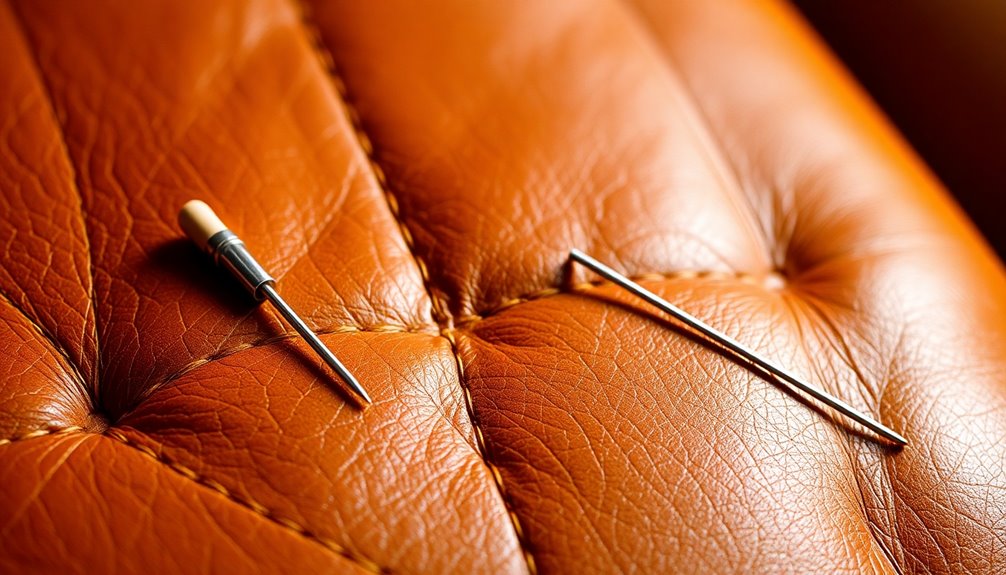
When it comes to upholstery seam reinforcement, addressing frame weaknesses is essential for a sturdy foundation. You can use leather stitching repair techniques to enhance both durability and your seating experience. By taking these steps, you'll ensure your sofa remains both functional and visually appealing.
Frame Weaknesses
Inspecting upholstery seams is crucial for identifying potential weaknesses that could compromise your leather sofa's overall structure. Start by assessing the seams for signs of weakness or fraying, as these areas are vital for maintaining the integrity of your leather items. If you notice any issues, it's essential to address them promptly.
For reinforcement, use high-quality bonded nylon thread for sewing. This thread offers durability and flexibility against stress from regular use. Before sewing, apply a fabric or leather glue to the seam area; this creates a stronger bond and helps prevent further fraying. If you have heavily used seams, consider adding a patch of durable fabric or leather over the existing seam for extra support.
Regularly inspect and maintain seam integrity to avoid larger repairs down the line. By being proactive, you'll ensure the longevity of your sofa's upholstery and maintain its aesthetic appeal. Remember, leather using high-quality materials and proper techniques can save you time and money in the long run. Your attention to these details will keep your leather sofa in great shape for years to come.
Leather Stitching Repair Techniques
Leather stitching repair techniques are essential for maintaining the durability and appearance of your sofa. When restoring leather, you'll want to start by assessing the seam area for any fraying or damage. Trim any loose threads to create a clean edge, which makes for a more effective repair. Using high-quality bonded nylon thread is crucial—this ensures strong and durable stitches that can withstand daily wear and tear on your leather couch.
Next, grab a curved needle designed specifically for leather. This tool will help you navigate the thickness of the material and achieve a neater finish, especially in tight or curved areas. Before you start stitching, consider applying leather adhesive along the seam. This enhances the bond and helps prevent further fraying of the material.
Always test your stitching technique on a scrap piece of leather first. Doing so allows you to determine the best tension and stitch length, ensuring you achieve a professional-looking repair. With these methods, you'll not only restore your leather couch but also extend its lifespan, keeping it looking great for years to come.
Enhanced Seating Experience
A sturdy sofa is a joy to sit on, but over time, the seams can weaken and compromise your comfort. To enhance your seating experience, focus on upholstery seam reinforcement. Start by inspecting the seams regularly for signs of wear. Catching issues early can save you from major repairs later. When you find weak seams, use high-quality bonded nylon thread to sew them securely. Whether you opt for a sewing machine or hand-sewing techniques, make sure the stitches are evenly spaced and tightly anchored to withstand daily use.
For added durability, consider adding a leather backing to the seams. This extra support helps distribute stress and reduces the chance of future damage. Regular maintenance is crucial too; conditioning the leather keeps it clean and prevents dryness and cracking, which can lead to seam failures. By reinforcing the seams and taking care of your leather, you'll not only restore leather to its former glory but also ensure a comfortable and sturdy seating experience for years to come. With these steps, you'll enjoy your sofa even more, knowing it's built to last.
Personalized Leather Color Treatment
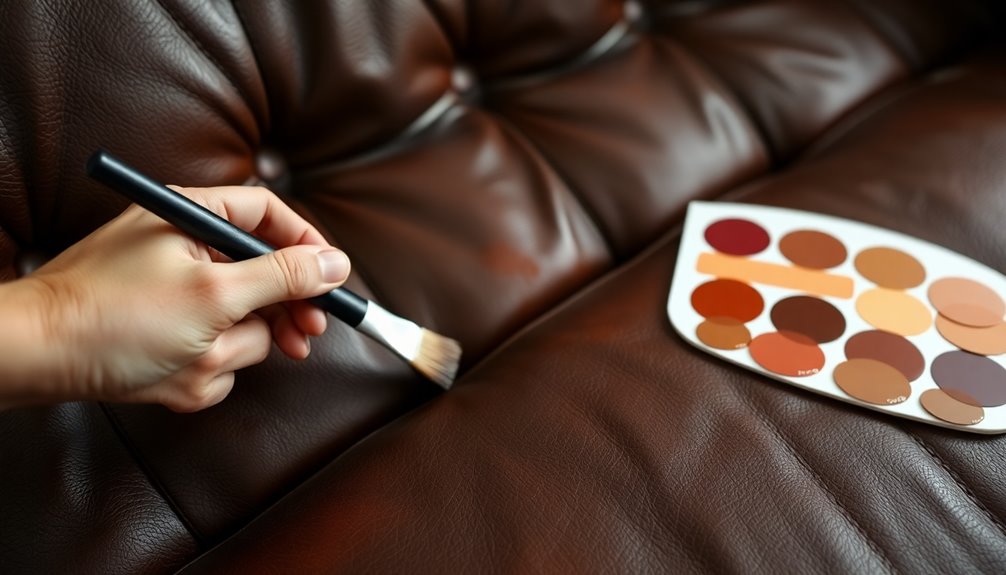
When your leather sofa starts to show signs of fading, personalized leather color treatments can breathe new life into it. You can effectively restore those faded areas by using leather dye or color restorers specifically formulated for your sofa's leather type, ensuring you match the original color. Before diving in, it's crucial to test the product on an inconspicuous area first. This way, you can assess compatibility and decide on the desired results.
For absorbent leather types, like Aniline and Pull Up leathers, a single application of a Leather Re-Colouring Balm is often enough, with reapplication recommended every three years to maintain vibrancy. When applying the treatment, use a cloth to ensure even coverage and avoid over-saturation.
Using high-quality leather color restoration products will significantly reduce the appearance of scratches and fading caused by sunlight exposure, enhancing your sofa's overall aesthetic. Remember to follow the manufacturer's instructions, allowing adequate drying time between coats to achieve optimal results and a uniform finish. With the right approach, your leather sofa can look refreshed and vibrant again!
Seasonal Leather Maintenance Tips
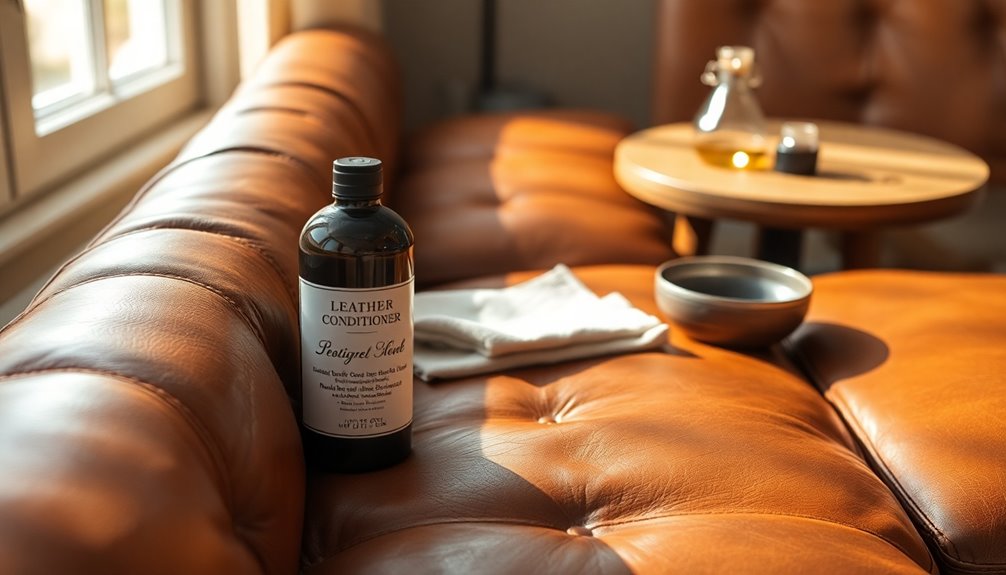
To keep your leather sofa looking its best throughout the year, regular maintenance is key. Start by cleaning your leather sofa at least once a month. Use a damp microfiber cloth along with a gentle cleaning solution to remove dust and dirt buildup, preventing long-term damage.
Condition your leather every six months with a high-quality leather conditioner to maintain hydration and prevent cracking, especially if you live in a dry or fluctuating climate. Protect your sofa from direct sunlight by positioning it away from windows or using UV protectant sprays, as prolonged exposure can lead to fading and drying.
Additionally, consider using a leather protector spray regularly to create a barrier against stains and moisture. Make sure to address spills immediately to avoid lasting damage.
Lastly, maintaining stable indoor temperature and humidity levels is crucial. Ideally, keep your home between 60-80°F and 40-60% humidity to prevent leather from drying out or becoming too moist and moldy. Following these seasonal maintenance tips will help ensure your leather sofa remains in excellent condition for years to come.
Conclusion
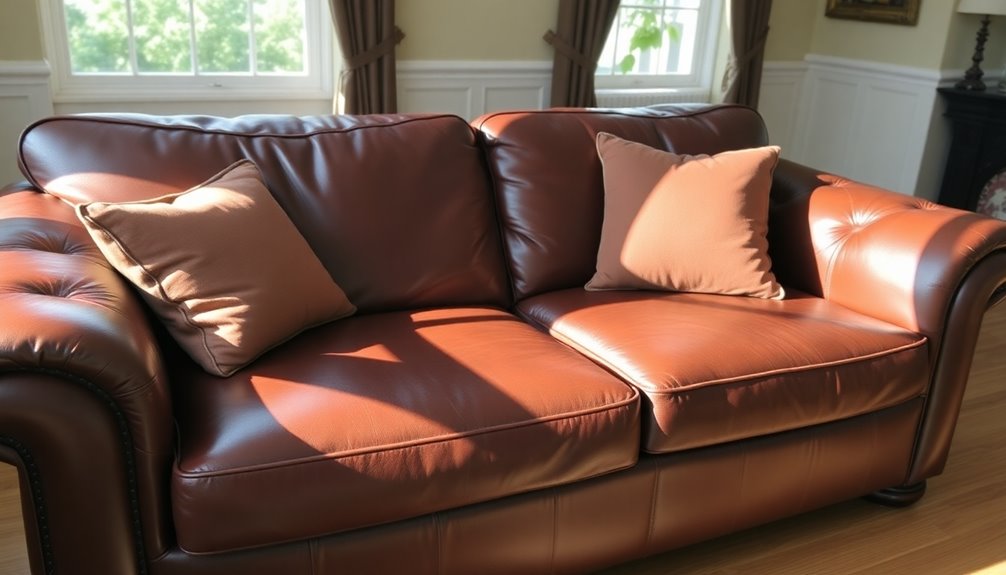
In summary, restoring your leather sofa not only revitalizes its appearance but also extends its lifespan significantly. By using effective cleaning and conditioning techniques, you can achieve impressive results in about an hour. Products like Leather CPR 2-in-1 Cleaner and Conditioner are great for getting rid of stains and rejuvenating the leather, making them a popular choice for many restoration projects.
Regular maintenance is crucial to keep your sofa looking its best. Conditioning every six months and promptly cleaning up spills will help sustain the quality and aesthetics of your leather furniture. Remember, different types of leather require specific care, so take the time to understand your sofa's characteristics for the best results.
Don't just take our word for it; customer testimonials and endorsements from reputable sources reinforce the effectiveness of these restoration products. With the right approach and tools, you can enjoy a beautiful, well-maintained leather sofa for years to come. So, roll up your sleeves and embark on this rewarding journey of restoration; you'll be glad you did!
Frequently Asked Questions
How Do I Make My Leather Sofa Look New Again?
To make your leather sofa look new again, start by cleaning it with a solution of equal parts white vinegar and water. Use a microfiber cloth and work in small circles to remove dirt. Next, apply a leather conditioner to restore moisture and flexibility, buffing it with a soft cloth afterward. For any scratches or faded areas, use a suitable leather dye or conditioner, ensuring to test it first in a hidden spot. Additionally, regular maintenance can help prevent future wear and tear. When fixing leather sofa issues, be proactive by cleaning it every few months and ensuring it’s not placed in direct sunlight, which can cause fading. If your sofa shows signs of more severe damage, consider consulting a professional for repairs to keep it looking its best.
Can You Bring a Leather Couch Back to Life?
Absolutely, you can bring a leather couch back to life! Start by cleaning it with a damp cloth to remove dirt and grime. Then, apply a high-quality leather conditioner to nourish and protect the material. If you've got scratches or fading, consider using specialized repair products to address those issues. With some care and the right products, your leather couch can regain its luster and look fantastic again!
Is It Worth Restoring a Leather Sofa?
You might wonder if restoring a leather sofa is worth it, and the answer often leans toward yes. By investing in restoration, you can extend its lifespan and preserve its unique character. It typically costs less than buying new furniture, and regular maintenance can prevent costly replacements down the line. Plus, many customers rave about the impressive results they achieve, making it a smart choice for enhancing your home decor.
What Is the Best Thing to Restore Leather?
The best thing to restore leather is a high-quality leather restoration cream or balm. Products like Leather CPR or Leather Re-Colouring Balm work wonders by addressing color fading and enhancing appearance. Leather CPR cleans and conditions in one go, making it super convenient for you. For absorbent leathers, a single application of the balm can rejuvenate color and protect against sun damage. Just remember to test it on a small area first!
